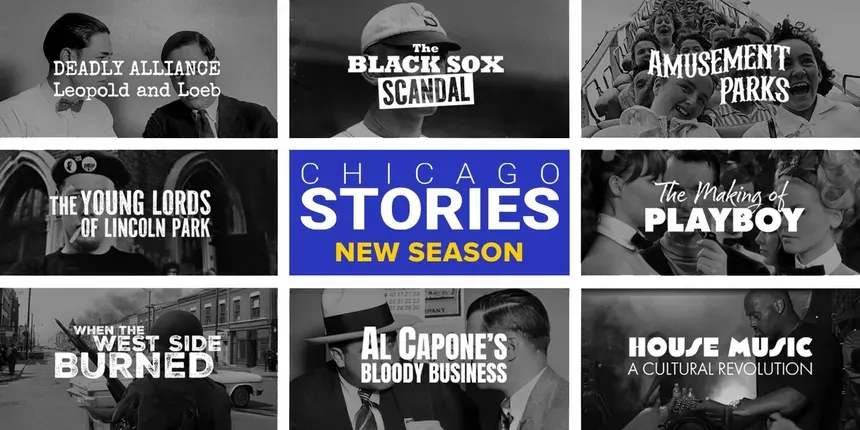Chicago Stories
Lincoln Park's Puerto Rican Community
Clip: 10/11/2024 | 5m 6sVideo has Closed Captions
Lincoln Park was once home to a vibrant Puerto Rican community.
Long before it was an affluent neighborhood of multimillion dollar homes, Lincoln Park was home to a small but vibrant Puerto Rican community.
Chicago Stories is a local public television program presented by WTTW
Leadership support for CHICAGO STORIES is provided by The Negaunee Foundation. Major support for CHICAGO STORIES is provided by the Elizabeth Morse Genius Charitable Trust, TAWANI Foundation on behalf of...
Chicago Stories
Lincoln Park's Puerto Rican Community
Clip: 10/11/2024 | 5m 6sVideo has Closed Captions
Long before it was an affluent neighborhood of multimillion dollar homes, Lincoln Park was home to a small but vibrant Puerto Rican community.
How to Watch Chicago Stories
Chicago Stories is available to stream on pbs.org and the free PBS App, available on iPhone, Apple TV, Android TV, Android smartphones, Amazon Fire TV, Amazon Fire Tablet, Roku, Samsung Smart TV, and Vizio.

Chicago Stories
WTTW premieres eight new Chicago Stories including Deadly Alliance: Leopold and Loeb, The Black Sox Scandal, Amusement Parks, The Young Lords of Lincoln Park, The Making of Playboy, When the West Side Burned, Al Capone’s Bloody Business, and House Music: A Cultural Revolution.- To understand the Young Lords, you really have to understand the history of Lincoln Park and the history of the neighborhood.
- [Narrator] Lincoln Park today, is a high class bastion of wealth, luxury, and privilege.
One of the most affluent neighborhoods in Illinois.
- The streets are lined with, you know, multimillion dollar homes, lots of fancy shops and boutiques.
(melodious music) - [Narrator] But it wasn't always that way.
In the 1940s and early 1950s, Lincoln Park was home to a diverse population of poor people, mainly ethnic whites.
Then, Puerto Ricans started arriving.
- [Lilia Fernandez] There was widespread poverty and unemployment in Puerto Rico, and many people were coming to the mainland to look for work.
- [Johanna Fernandez] We're talking about a third of the people of the island.
(melodious music) - [Narrator] Before 1946, there were fewer than 500 Puerto Ricans living in Chicago.
Over the next decade, that number would jump to more than 30,000.
David Rivera arrived at age 5.
- My family flew into Chicago, 'cause I remember as a little tiny kid, looking at this big car and looking at all the big buildings as we drove to where we were going.
(melodious music) - [Narrator] The Riveras landed in an apartment building on Dayton Street in Lincoln Park, and young David quickly found a friend who lived upstairs, named Jose "Cha Cha" Jiménez.
- We just became friends automatically.
You know, two kids.
Cha Cha and I hit it off right away.
We were a group of kids, you know, we used to get together in the back alleys and play all kinds of games.
- [Narrator] Rivera couldn't have known that within a few years, his friend Cha Cha Jiménez would rise up to become a revolutionary leader.
In this 2012 interview, Cha Cha remembers the Lincoln Park of his childhood.
- The Lincoln Park neighborhood was an ethnic community, was a very segregated community, Polish people, or Italian people, or German people, gypsies, hillbillies, and Puerto Ricans.
And so we were the new kids on the block at that time.
- Lincoln Park is the place where they're introduced to what it means to be an American, and they themselves are engaging in that process.
- [David Rivera] We used to play war a lot.
Our heroes were the TV shows, "Davy Crockett."
- [Narrator] Though influenced by mainstream American culture, the boys were surrounded by a growing number of Puerto Ricans who were establishing a sense of their homeland in Lincoln Park.
But it hadn't been easy.
When Puerto Ricans first arrived, many settled in a near north slum, nicknamed La Clark.
Cha Cha Jiménez's family landed there when he was 4 years old.
- La Clark was a skid row neighborhood, with dilapidated buildings and dive bars.
The neighborhood was poor and working class, but it was vibrant, and it was home.
- [Narrator] But they wouldn't live in La Clarke for long.
- The city had essentially decided that this was an eyesore because it was too close to the Gold Coast.
(building crashing) - [Narrator] Mayor Richard J. Daley was promoting urban renewal, replacing slums with luxury housing, and his crown jewel was in the works.
Named for the famous poet, Carl Sandburg Village was heralded by developers as a village within the city.
- The Carl Sandburg Village, eventually, there'll be 1,875 dwelling units in this village.
- Cha Cha Jiménez and his family are literally in the path of the wrecking ball.
- [Narrator] The tight knit barrio the Jiménez's was called home was destroyed almost overnight.
- [Reporter] The clearance of slum and blight is impressive, and the results are outstanding.
(crane rumbling) - [Narrator] Daley's promotional film failed to mention the human cost.
More than 900 Puerto Rican families were forced out.
- Instead of the city welcoming the new immigrants in, what they were doing was to displace them and just push 'em to another neighborhood.
Chicago Stories is a local public television program presented by WTTW
Leadership support for CHICAGO STORIES is provided by The Negaunee Foundation. Major support for CHICAGO STORIES is provided by the Elizabeth Morse Genius Charitable Trust, TAWANI Foundation on behalf of...












